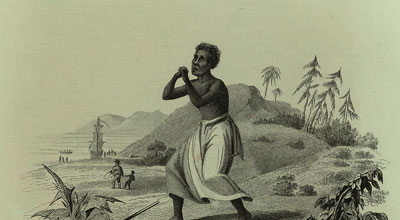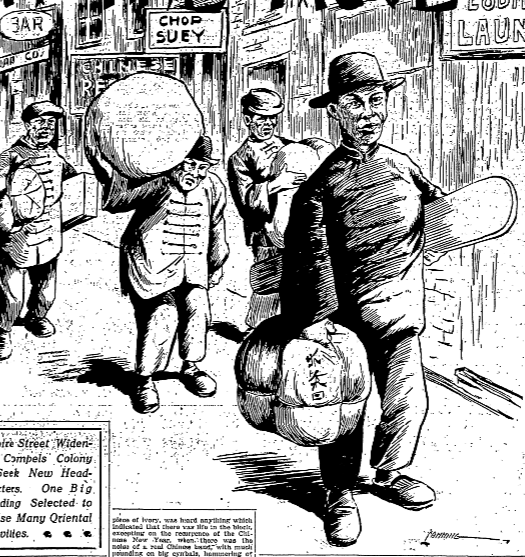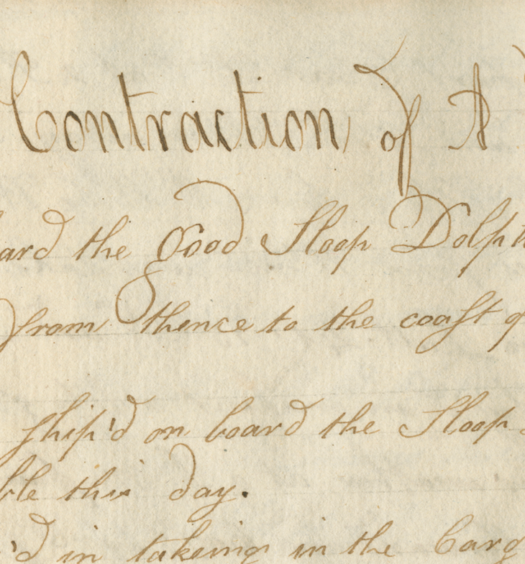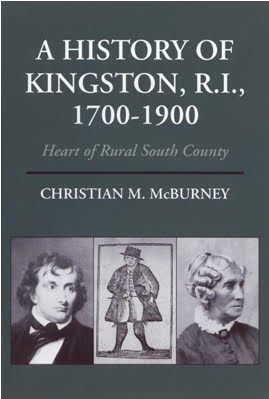With the ideology of equality and natural rights permeating American culture after the Revolutionary War, the system of slavery that had been quietly introduced in the American colonies in colonial times now appeared as an embarrassment. The northern states, starting with Pennsylvania in 1780 and ending with New Jersey in 1804, gradually cleansed themselves of slavery.
In Rhode Island, this story played out in communities large and small. This article focuses on Kingston, then known as Little Rest. In colonial days, Little Rest was the center of government for the southern part of Rhode Island in King’s County (now known as South County). Little Rest held sessions of the county court, was the seat of government for the town of South Kingstown (then including Narragansett), and served as one of the state’s five rotating capitals. In colonial times, King’s County, also called the Narragansett country, experienced the rise of large dairy farms worked by relatively large (for New England) numbers of slaves. A typical farm would have had about 400 sheep, 100 cattle and 30 horses, including the famous Narragansett Pacer, with about ten slaves working the farm and assisting in the house as servants. In colonial times, the Narragansett country had the highest percentage of slaves in rural.
Rhode Island did not enact a bill for the immediate abolition of slaves. Instead, it enacted a gradual emancipation bill. In 1784, the General Assembly enacted a law providing that any black person born after the law was enacted was to be considered a free person. This was far more complicated than a simple immediate abolition. For one, the state and town councils had to determine what to do with children who were born free to mothers who continued as slaves.
The preamble to the 1784 act was written in the ideological language of the day: “Whereas, all men are entitled to life, liberty, and the pursuit of happiness, and the holding mankind in a state of slavery, as private property, which has gradually obtained by unrestrained custom and the permission of the laws, is repugnant to this principle, and subversive of the happiness of mankind, the great end of all civil government. . . .”
The body of the act then addressed the children of slaves, stipulating that “no person or persons, whether negroes, mulattoes, or others, who shall be born within the limits of this state, on or after the first day of March, A.D., 1784, shall be deemed or considered as servants for life, or slaves,” and that “all servitude for life, or slavery of children, to be born as aforesaid in consequence of the condition of their mothers, be, and the same is hereby taken away, extinguished, and forever abolished.” Noting that “humanity requires” that “children, declared free as, aforesaid” remain with their mothers “a convenient time” after being born, the act required town councils to reimburse “those who claim the services” of their mothers for the costs of supporting the children during that time.
In addition, the town councils were required to reimburse slave owners for the educational, moral and religious instruction of such children, according to the “earnest desire of this Assembly.” This was a relatively enlightened approach to insure that the children of slaves received a decent upbringing, including some education and religious instruction. Furthermore, the act authorized the town councils to bind out the children as apprentices between the ages of one year and 21 years if males and one year and 18 years if females to achieve these ends. Finally, the act released slave owners freeing slaves between the ages of 21 (for a male) or 18 (for a female) and 40 from further obligation to financially support the freed slaves, on condition that the town council determine that the freed slave was healthy.
The relatively enlightened approach did not last long. An amendment to the emancipation act was passed in October 1785 that undermined the freedom granted to children in the 1784 act. In the 1784 act, the town councils reimbursed slave owners for the maintenance of the free-born children. This spread the cost among all taxpayers. But the 1785 amendment repealed this public support provision and required “that every negro of mulatto child born after the first day of March, A.D. 1784, be supported and maintained by the owner of the mother of such child, to the age of twenty-one years, provided the owner of the mother shall during that time hold her as slave.” It was likely the case that slave owners would have little incentive to provide a decent life for the children of their slaves without assistance from the towns. Only the manumission of the mother would discharge the owner from responsibility for the child’s support. Moreover, the Assembly’s “earnest desire” to educate the children of slaves had evaporated. Finally, the amendment reduced the upper age limit from 40 to 30 years for slaves who might be manumitted without further financial responsibility on the part of the owners.
After the gradual emancipation act passed in 1784, Little Rest white families continued to hold some black persons as slaves. In the 1790 census, the following Little Rest heads of households were recorded as holding black slaves: Elisha Reynolds (4); Colonel Robert Potter (5); Henry Reynolds (1); Robert Sands (1); and Hannah Champlin (1). The total number of slaves went from 18 in 1774 to 12 in 1790.
By 1800, only one person held a slave in Little Rest. Elisha Reynolds Potter, a wealthy farmer and influential state politician who for many years served as speaker of the lower house in the General Assembly, owned the only slave, named John Potter. It is not clear how Potter came to own the slave; probably, it was through inheritance.
In South Kingstown as a whole, in 1800, census takers counted 375 free blacks and only 44 slaves. It appears that after 1790, the social and moral environment had changed and that holding slaves was no longer seen as acceptable. In addition to the ideology of the American Revolution, this transformation may have also been influenced in part by Rhode Island’s adoption of the U.S. Constitution in 1790, and by the state’s influential Quaker community supporting abolition. Even though legally, slaveholders holding slaves born prior to 1784 did not have to manumit them, they chose not to hold onto them. Most slaves who were born before 1784 were simply freed by their masters.
Some Little Rest villagers, along with their townsmen, obtained certificates from the town manumitting their black slaves. Others in their wills manumitted their slaves.
Wills often dealt with the many complex situations that arose. Joseph Perkins, a Little Rest merchant and silversmith, in his 1789 will, addressed the circumstance of a black slave who had liberated himself by running away. Perkins ordered that “if my Negro Man called Phillip should return” that he be treated as a free man. Perkins generously willed a house and a lot of land to a freed black man who worked for him, Javin Niles.
Elisha Reynolds dealt with five black slaves in his 1791 will. One of the circumstances was complicated, as the slave was a mother who had given birth to a child after 1784. Reynolds freed his slave, Lydia, and gave Lydia the remaining time of her slave daughter Genny, until Genny turned 18, when Genny too would be free. Reynolds also freed his male slave, Torn. He further stipulated that if Lydia and Tom could not support themselves, that income from his estate should be used to support them. Elisha Reynolds Potter, the grandson of Elisha Reynolds, recorded for several years in his expense book charges against Reynolds’ estate for boarding Tom and for purchasing leather shoes for Tom.
By contrast, Reynolds did not free his other two slaves, female Jesse and male Caesar. Instead, he gave them to his daughter Elizabeth Potter for her life; after her death Jesse was to be owned by Thomas Potter and Caesar by Elisha R. Potter. It may have been that Reynolds did not free them because he felt that Jesse and Caesar could not support themselves, perhaps because they were elderly. Because Thomas Potter died in 1793, Elisha Potter may have inherited Jesse. Jesse and Caesar apparently were free persons by 1800. Caesar purchased goods from Elisha Potter’s store in 1791.
In his will in 1790, Narragansett planter Benjamin Peckham, who lived a short way up North Road from Little Rest, transferred ownership of his male slave Philo to his son Josephus. However, Benjamin ordered that in seven years, in 1797, when Philo turned age 33, he was to be freed and given “ten silver Spanish milled Dollars.” Benjamin Peckham did not manumit another young male slave, named Quom. Quom was born blind and never regained sight. Benjamin wanted his family members to take care of Quom, requesting that Quom “be treated kindly.”
The manumission provisions of the gradual emancipation statute were a source of persistent conflict over the support of ex-slaves between town councils and slave owners. The 1784 act permitted slave owners to be released from further financial responsibility for a freed slave, if the male slave was freed between the ages of 21 and 30, and if the female slave was freed between the ages of 18 and 30. As a condition to such manumissions, the town councils had to declare that the slave in question was healthy.
The town councils wanted to insure that a slave when freed could enter the free work force and support himself or herself without support from town coffers. When South Kingstown slave owners sought to employ the provision giving them the right to manumit slaves without further financial responsibility for their welfare, resistance of the town council grew. At first, after 1784, the South Kingstown town council regularly found that a black man or woman met the requirements of the emancipation statute. But the town council became increasingly concerned that freed slaves would not be able to support themselves and would thus have to be supported by it, at taxpayer expense.
The concern about emancipating slaves was first expressed by the town council in 1793. Josephus Peckham, who lived a short way up North Road from Little Rest, brought before the town council Philo Peckham, the “Negro Man Slave” that he had inherited in 1790 from his father and requested that Philo be emancipated. Recall that in his father’s will, Philo was required to be freed in 1797. Josephus was willing to free Philo prior to that time. Four members of the council agreed that Philo fell within the provisions of the law to be freed, but for the first time, one of the council members dissented. This single dissent eventually grew into a majority. The South Kingstown town council, facing a large number of blacks still held in bondage in the town, stubbornly refused to authorize manumissions of individual black persons who clearly were entitled to be freed under the statute. In 1804, the town council refused to manumit a slave on the ground that “the Town ought not to be put in jeopardy of any expense whatever.”
Another rejected manumission led to a lawsuit brought by Elisha Gardner, the county deputy-sheriff who owned a home in Little Rest that still stands today on South Road near the corner at Main Street and South Road. Gardner was the co-executor and a beneficiary of the estate of his uncle, Caleb Gardner, who died in 1796. Caleb Gardner had been a well-to-do Narragansett planter who had two farms near Little Rest, one of which was located immediately to the north of Main Street in Little Rest and to the east of North Road. Caleb Gardner was also a long-time slaveholder. He was recorded as having six black persons residing on his lands in 1774 (all of whom likely were slaves) and seven black slaves residing on his lands in 1790. The increase was apparently attributable to the birth of Patience after 1784 from a black woman who was a slave owned by Caleb Gardner. Patience was part of Caleb Gardner’s estate when the planter died in 1796.
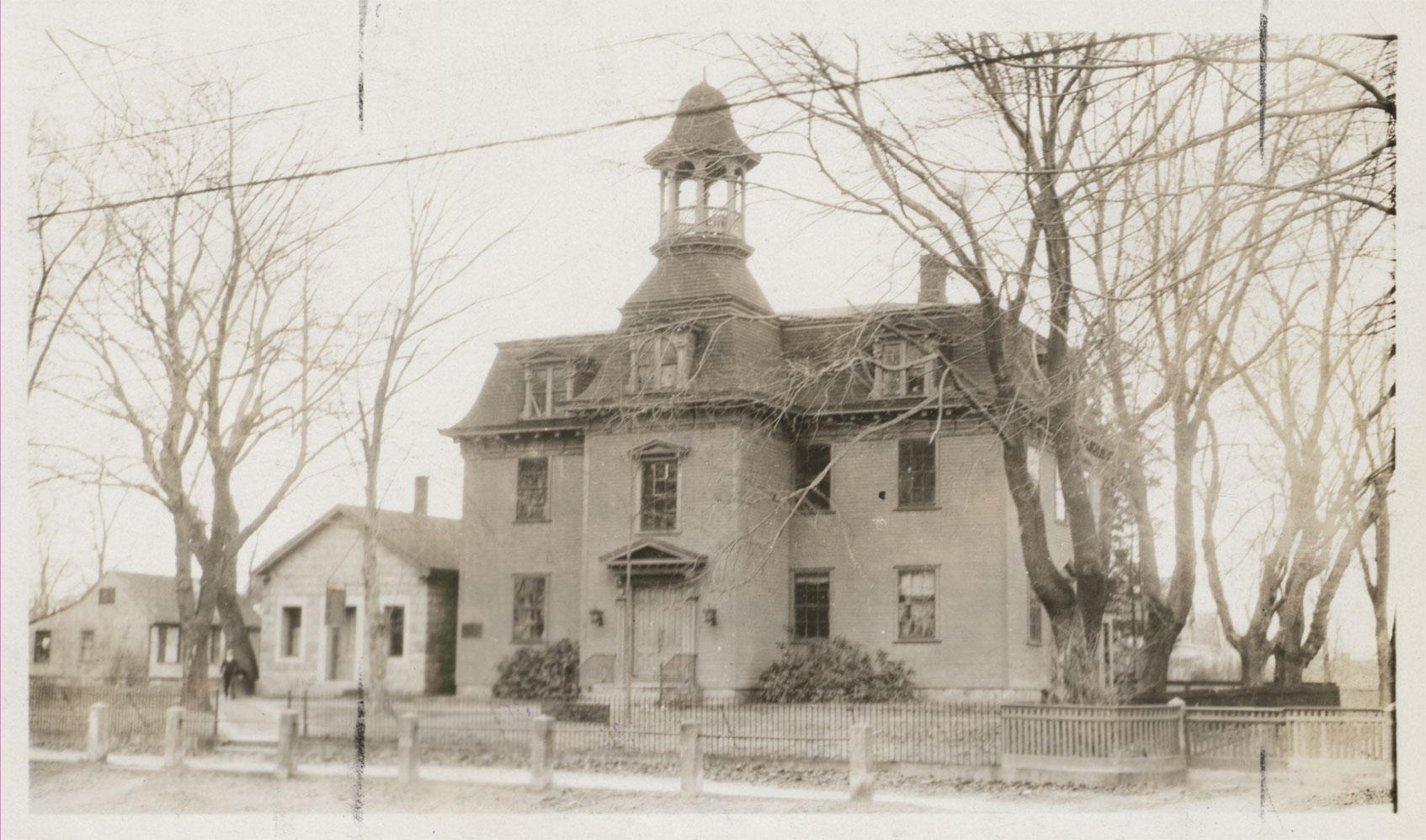
The Washington County Court House, circa 1920. More than 100 years earlier the case to free the slave Patience was brought here, and won (State Archives)
Once Patience reached the age of 18, Elisha Gardner applied to the South Kingstown town council to declare that she was healthy and could be set free. On August 11, 1806, at a meeting of the town council in the Joseph Reynolds tavern in Little Rest, Gardner presented Patience and requested “that this Council would manumit said Patience,” as her circumstances fell within the 1784 gradual emancipation legislation. The town council, however, rejected the request.
Gardner responding by filing suit in the Court House in Little Rest (now the Kingston Free Library), but the probate court ruled against Gardner. Finally, in October 1808, the county supreme court reversed the probate court, finding that Patience clearly fell within the terms of the emancipation act. The County Supreme Court ordered that “Patience be manumitted and forever hereafter liberated and emancipated.”
This shameful situation, in which a local government body prevented the freedom of slaves in clear contravention of the applicable statute, not to mention morality, must be attributed to several factors. The first factor was the failure of the General Assembly to provide means for the freed black slaves to support themselves. Freed slaves were not given any money or property by the state, and were often forced into servant relationships with their former masters. The second factor was the unsatisfactory system of Rhode Island towns handling poor relief. Since colonial times, town councils had the duty of caring for inhabitants who could not support themselves. The money was given out grudgingly in individual cases. This was not a system that was designed to handle a circumstance such as the freedom of a large number of slaves who previously had not been permitted to educate or support themselves. Under pressure from rebellious taxpayers, and relying on an outmoded welfare system, the South Kingstown town council itself rebelled. Not until later in the nineteenth century would welfare relief take the form of isolating the poor in “town farms” or in asylums, where they could be supported relatively cheaply. The third factor was that the town council made a value judgment that the freedom of a slave was worth less than the possibility of adding to the burden of the town’s taxpayers.
In August 1810, Elisha Potter brought his slave John Potter before the town council and the town council agreed to issue John a certificate demonstrating his freedom. Presumably, John Potter had just turned 21 years of age and qualified for emancipation under the 1784 statute. John Potter was Little Rest’s last slave.
[Banner Image: Drawing of a female slave in the British West Indies, 1826]Bibliography: This article is from the author’s A History of Kingston, R.I., 1700-1900, Heart of Rural South County (Pettaquamscutt Historical Society, 2004). For a full bibliography, see the book at pages 341-42. I extend credit to Professor Joanne Pope Melish for uncovering the Elisha Gardner and Patience case, at page 98, in her excellent Disowning Slavery: Gradual Emancipation and “Race? In New England, 1780-1860 (Ithaca, NY: Cornell University Press, 1998). Other sources include Washington County Court Records at the Rhode Island Judicial Archives in Pawtucket, and South Kingstown Town Council Records, and South Kingstown Probate Records, at the South Kingstown Town Hall in Wakefield.

